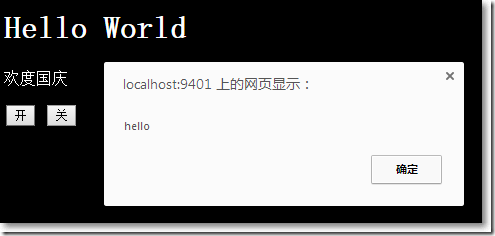本篇體驗JavaScript事件的基本面,包括:
■ 事件必須在頁面元素載入之後起效
■ 點選事件的一個簡單例子
■ 為元素註冊多個點選事件
■ 獲取事件引數
■ 跨瀏覽器事件處理
□ 事件必須在頁面元素載入之後起效
有這樣一段簡單的程式碼:
<head><meta http-equiv="Content-Type" content="text/html; charset=utf-8"/><title></title><style>#box {background: blue;height: 100px;width: 100px;left: 50px;top: 50px;}</style></head><body><div id="box"></div></body>
現在,我們想給id為box的div新增事件,建立一個script.js檔案。
(function() {var ele = document.getElementById("box");ele.onclick = function() {this.style.background = "red";};}());
是一個匿名函式,只要被引用,自動執行。
如果把script.js放在head區域。
<head><meta http-equiv="Content-Type" content="text/html; charset=utf-8"/><title></title>......<script src="script.js"></script></head>
點選頁面藍色區域會報錯:Cannot set property 'onclick' of null
找不到需要實施onclick事件的元素。如果我們把script.js放在body區域底部,又會怎樣呢?
<body><div id="box"></div><script src="script.js"></script></body>
點選頁面藍色區域背景色變成紅色。
由此可以看出:事件必須在頁面元素載入完畢之後才可以實施。
以上,通過把JavaScript程式碼放在需要實施事件元素的下方,保證了先載入元素,再執行事件,這很好。而實際上,通過window的onload方法也可以保證所有頁面元素載入完畢再執行事件。
修改script.js的程式碼為:
(function () {window.onload = function() {var ele = document.getElementById("box");ele.onclick = function () {this.style.background = "red";};};}());
把script.js程式碼放在head部分。點選頁面藍色區域背景色變成紅色。
□ 點選事件的一個簡單例子
<head><meta http-equiv="Content-Type" content="text/html; charset=utf-8"/><title></title><style>.on {background-color: white;color: black;}.off {background-color: black;color: white;}</style><script src="script.js"></script></head><body class="on"><h1>Hello World</h1><p>歡度國慶</p><button id="open">開</button><button id="close">關</button></body>
script.js的程式碼為:
(function () {window.onload = function() {var openBtn = document.getElementById("open");var closeBtn = document.getElementById("close");openBtn.onclick = function() {document.body.className = "on";};closeBtn.onclick = function() {document.body.className = "off";};};
一切執行正常。但,如果我們在script.js中給開按鈕再註冊一個事件。
(function () {window.onload = function() {var openBtn = document.getElementById("open");var closeBtn = document.getElementById("close");openBtn.onclick = function() {document.body.className = "on";};closeBtn.onclick = function() {document.body.className = "off";};openBtn.onclick = function() {alert('hello');};};}());

當點選"開"按鈕後,彈出alert。由此可以看出:每次只能為元素註冊一個onclick事件。
□ 為元素註冊多個點選事件
使用addEventListener方法,可以為元素同時註冊多個點選事件。
修改script.js程式碼如下:
(function () {window.onload = function() {var openBtn = document.getElementById("open");var closeBtn = document.getElementById("close");var open = function() {document.body.className = "on";};var close = function() {document.body.className = "off";};//第三個引數設定成false,表示允許事件冒泡openBtn.addEventListener("click", open, false);openBtn.addEventListener("click", function() { alert('hello'); }, false);closeBtn.addEventListener("click", close, false);};}());
當然,也可以移除註冊的事件。
//移除EventListner事件openBtn.removeEventListener("click", open, false);
注意:在IE8下沒有addEventListner,應該使用attachEvent。
openBtn.attachEvent("onclick", function(evt)){alert(evt.srcElement);//相當於target屬性document.body.className = "on";};
○ attachEvent只有2個引數
○ 事件名稱是onclick,而不是click
○ event.srcElement相當於event.target
如果在IE8下注銷事件。
openBtn.detachEvent("onclick",函式名稱);
□ 獲取事件引數
在每次發生事件的時候,所有的事件引數資訊都被放在了一個event變數中。修改script.js程式碼為:
(function () {window.onload = function() {var openBtn = document.getElementById("open");var closeBtn = document.getElementById("close");var open = function (e) {alert(e.type + " " + e.target);document.body.className = "on";};var close = function (e) {alert(e.type + " " + e.target);document.body.className = "off";};//第三個引數設定成false,表示允許事件冒泡openBtn.addEventListener("click", open, false);closeBtn.addEventListener("click", close, false);};}());
可見,函式的事件引數在大多數情況下被省略了,如果想獲取事件資訊,這個event引數還是很有用的。
□ 跨瀏覽器事件處理
正因為,在不同的瀏覽器下事件處理方式不同,比如在chrome下接收addEventListener方法,而在IE8下接收attachEven方法,我們有必要針對跨瀏覽器提供一個通用的事件處理機制。
建立eventUtiltiy.js檔案。
var eventUtility = {addEvent: function(ele, type, fn) {if (typeof addEventListener !== "undefined") {ele.addEventListener(type, fn, false);} else if (typeof attachEvent !== "undefined") { //比如在IE8下ele.attachEvent("on" + type, fn);} else {//獲取屬性通過obj.屬性名稱,等同於obj[屬性名稱]//執行事件通過obj.事件名稱,等同於obj[事件名稱]ele["on" + type] = fn;}},removeEvent: function(ele, type, fn) {if (typeof removeEventListener !== "undefined") {ele.removeEventListener(type, fn, false);} else if (typeof detachEvent !== "undefined") {ele.detachEvent("on" + type, fn);} else {ele["on" + type] = null;}},getTarget: function(event) {if (typeof event.target !== "undefined") {return event.target;} else {return event.srcElement;}},preventDefault: function(event) {if (typeof event.preventDefault !== "undefined") {event.preventDefault();} else {event.returnValue = false;}},getCharCode: function(event) {if (typeof event.charCode === "number") {return event.charCode;} else {return event.keyCode;}}};
頁面部分。
<head><meta http-equiv="Content-Type" content="text/html; charset=utf-8"/><title></title><style>.on {background-color: white;color: black;}.off {background-color: black;color: white;}</style></head><body class="on"><h1>Hello World</h1><p>歡度國慶</p><button id="open">開</button><button id="close">關</button><script src="eventUtility.js"></script><script src="script.js"></script></body>
script.js部分。
(function () {var openBtn = document.getElementById("open");var closeBtn = document.getElementById("close");var open = function () {//alert(e.type + " " + e.target);document.body.className = "on";};var close = function () {//alert(e.type + " " + e.target);document.body.className = "off";};eventUtility.addEvent(openBtn, "click", open);eventUtility.addEvent(closeBtn, "click", close);}());
“JavaScript進階系列”包括: